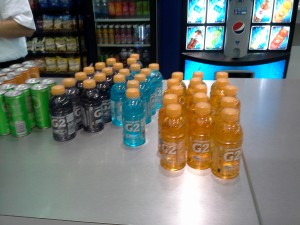Gatorade: the new health food?
On April 20, I received a letter from a Gatorade PR person commenting on one of my posts reposted at the Atlantic Health/Food section.
After reading the letter, I searched my posts for references to Gatorade but can’t find anything specific other than my reporting the more than $100 million a year Pepsi spends to advertise this product.
So I’m guessing the letter must be referring to my comments about sports drinks in general:
Hi Marion –
I recently read your article in The Atlantic and would like to make sure you have the most current information. Your article criticizes sports drinks, advising against them because the sugars and carbs will make you fat. It also discusses the main sweetener in most sports drinks is high fructose corn syrup.
I would like to point out the carbohydrates and calories are functional in Gatorade, a sports drink, and are meant to provide fuel specifically for athletes.
The ingredients in Gatorade are backed by years of scientific research that support the need for carbohydrate sugars for fuel during training or competition and we only recommend Gatorade during the active occasion.
Also, high fructose corn syrup is not an ingredient in any Gatorade products.
For those looking for a lower-calorie sports beverage, Gatorade offers G2, which delivers the same amount of electrolytes as original Gatorade but with half the calories. Gatorade also recently introduced G Series FIT 02 Perform, which is designed for a fitness athlete and has 10 calories per 8oz serving.
Please let me know if you have any questions or need any additional information.
Best,
Katie Montiel, Gatorade Communications
I’m always happy to hear from interested readers.
And aren’t you glad to know that sugar is a functional (translation: “good-for-you”) ingredient in Gatorade?



